|
THE FRENCH
COLONIAL MEDAL CLASPS
There is a large number of clasps for
the Colonial Medal, some of which are official ones, others are unofficial. Several
manufacturers have produced these bars over the years and thus these clasps vary both in
quality and in aspect.
Known manufacturers, the first four
delivering claps on behalf of the French government, the others producing privately made
ones, are :
- Mercier
- Roux
- Salat
- Monnaie de Paris
- Arthus-Bertrand
- Marie-Aubert
- Lemaitre
- Lasne-Bacqueville
- Chobillon
- Delande
- Mourgeon
|
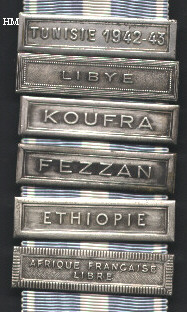
|
Depending on the manufacturer, maker's and/or silver
marks may be found on the clasps and one should also take into account that the same
manufacturer, having over the years to renew his dies, can have produced various types of
clasps.
A further point of interest is that original - 1st
issue - official clasps delivered by the government (manufactured by the first four on the
above list) are featuring "clipover" bars for attachment on the ribbon. Later
on, this was discontinued and "slipover" bars were - officially - used for the
same campaigns.
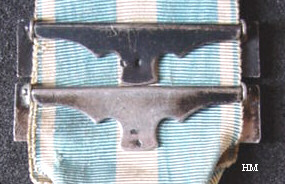
Also, so-called "Oriental"
clasps were manufactured by the Paris Mint after World War II. It is unclear why these
were made but I presume recipients of campaign medals featuring this type of bar requested
similar clasps for their Colonial Medal.

The information below on the official
clasps has been sorted historically and, where feasable, geographically. Between brackets
is the date of the clasp's decree of institution.
CAMPAIGNS BEFORE 1893
Original clasps are of the "à
clapet"-type whereby the reverse attachment bar is a "clipover bar" but
genuine slipover bars do exist also. These bars are fairly to very rare as most were
instituted retroactively and only surviving veterans could still claim them.
 |
(6 March 1894) : this
clasp covers operations and service from 1833 onwards. It was replaced, in 1900, by the
"Afrique Occidentale Française"-clasp for war operations but was still awarded
for service in the area up till 1907. |
 |
(6 March 1894) :
this is a very rare clasp and was awarded to the few remaining veterans of the maritime
operations between 18 September 1842 and 31 December 1843. This group of islands in
Polynesia (Pacific Ocean) was important to the French as a victualling and repairs stop
for ships rounding Cape Horn and it took up till 1880 to fully occupy the whole
archipelago and, more importantly, subdue the local cannibal population. |
 |
(6 March 1894) :
awarded for service in this Polynesian island group, especially on Tahiti, its main
island, between 13 March 1844 and 7 January 1847. No real warlike operations took place as
the islands' chiefs applied for the status of French Protectorate themselves in 1841 in a
reaction to irritating English missionaries' machinations. |
 |
(6 March 1894) : one
of a small group of islands north-west of Madagascar, this island was a refuge for the
Sakalave people against persecution on their native island of Madagascar. Faced with the
prospect of attacks by their opponents, the Hovas, protection by the French was asked for
and received. However, on 26 May 1849, a revolt by the Sakalaves broke out against their
French protectors and the small garrison had to successfully defend itself in a final
battle on 18 June. Pacification of the island took till 5 August 1849 and the clasp was
awarded to those that saw service between those dates. |
 |
(6 March 1894) :
originally called "Côte de l'Or", this clasp was awarded for operations in the
Grand Bassam River area between 16 March and November 1849. Later operations, between 25
October 1852 and 24 October 1853 also qualified for this bar. In both cases, these
operations were against pillaging and massacring local tribes. |
 |
(6 March 1894) :
awarded for operations or service towards maintaining the French flag on these islands
from 1853 onwards. Campaigns from 1853 till 1858, from May to September 1859, from 1861 to
1864 and in 1868-69 culminated in the Kanak Revolt of 1878 but even after years of peace,
further interventions were needed between 3 and 9 November 1916 and from 28 April 1917
till 31 January 1918. |
 |
(6 March 1894) :
the history of the first operations by France in the South Vietnamese region of today
could fill a book on its own and this clasp was awarded for those campaigns between 12
June 1857 and 2 December 1868. These operations were set up to protect French and Spanish
missionaries in the area (in the initial stages Spanish forces were fighting alongside the
French) who were being martyrised but also with acquiring ports for trade. Troops suffered
severely from cholera and dysentry and the bombardments and occupation of Hué (1857) and
Saigon (where 700 men held out under a 10 month siege in 1859) brings household names from
a later era back to mind. |
 |
(24 September
1895) : mainly awarded for operations between 1881 and 1883 resulting in the occupation of
large parts of this country. During World War I revolts in the South had to be put down
and participation in those operations also qualified for the award of this clasp. A
non-official clasp "SUD TUNISIEN" is believed to be related to these events as
well. |
CAMPAIGNS DURING THE 1893 - 1918
PERIOD
FAR EAST REGION :
 |
(29 November
1895) : this bar recognizes service in the area between 18 December 1880 and 28 August
1895 during which period Laos became part of the French colonial empire. Pacification was
not complete, of course, and further operations in 1904 and from 1907 to 1909 also lead to
the award of this clasp. |
 |
(9 May 1899) :
awarded to members of two expeditions on the Mekong river that extended French territory
in this area. A first expedition, commanded by Navy Lieutenant Simon, managed to negotiate
the Tang Ho rapids and reached Kieng Sen on the Birmese border on 21 October 1895. A later
expedition, between 20 May and 20 August 1897, commanded by Navy Lieutenant Mazeran and
using canoos reached Xien Hong, thus navigating the river and its rapids and waterfalls
along the entire stretch where it forms the border with Laos. An extraordinary feat as
this rocky and mountainous terrain was considered impossible to navigate even as late as
1929. |
 |
(30 June 1903) : a
decree of 12 April 1898 extended the award of the Colonial Medal to include civilians and
military that participated in non-military but hazardous operations in which they showed
courage. Thus a large number of exploratory, topographical, hydrographical, scientific,
archeological etc. expeditions made by medical doctors, scientist, missionaries, public
servants etc. and their military escorts fell within the scope of this medal. The ASIE
clasp recognizes 26 of these missions between 1882 and the early 1920's. |
EAST AFRICA REGION :
 |
(11 February
1899) : the Colonial Medal with this clasp is a sequel to the Commemorative Medal for
Dahomey that was instituted on 24 November 1892. This particular clasp was awarded for
participation in campaigns and operations in 1894-1895 and 1898-1899. These operations
served either to reconnoitre the entire territory or to reduce the last pockets of
resistance in the area. No longer awarded after 1900 for acts of war, service in the area
was still accepted for eligibility until 1905. |
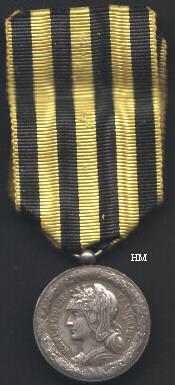
 |
(24 September
1895) : various operations against revolts but also expeditions to further chart the area
are commemorated by this clasp that spans a period of 7 years : from 1893 till 1900. From
1901 onwards, the "AFRIQUE OCCIDENTALE FRANCAISE" clasp was in use for
operations in this colony. |
 |
(4 August 1901) :
gradually replacing previous clasps, it was awarded for the numerous civil or military
operations in Cameroon, Dahomey, Togo, Guinea, Mauritania and the Soudan from 1900
onwards. During World War II the French Vichy government made use of this clasp for award
to the defenders of Dakar (see below). |
 |
(25 November 1904) :
first awarded for operations between 24 March and 25 April against the Koniaguis, this
clasp was also made available to reconnoitering missions for the Konakry to Niger railroad
line between 1904 and 1907. From 1909 onwards, the "AFRIQUE OCCIDENTALE
FRANCAISE" clasp was in use for operations in this colony. |
 |
(3 August
1909) : awarded for either operations or service in the Trarza area in 1908. Prior to
1902, the "SENEGAL ET SOUDAN" clasp was used whereas, with the exception of this
one year of 1908, the "AFRIQUE OCCIDENTALE FRANCAISE" clasp was in use from 1902
onwards. See also the next bar : "ADRAR". |
 |
(3 August 1909) :
as with the "MAURITANIE" clasp, this bar was awarded for operations in the
Trarza area in 1909 only. The occupation of this desolate desert area immediately to the
southeast of Spanish Morocco proved very hard because of the climate and the obstinate
resistance of the local tribes. A campaign of 10 months with a force of just over 1,000
soldiers, was needed to subdue the last of the opposing warriors. |
EQUATORIAL AFRICA REGION and GRAND
MISSIONS :
 |
(30 September
1900) : originally awarded to survivors of the 1880-81 mission that was massacred by the
Touaregs, this clasp served to commemorate a large number of operations in the area up
till 1936. It was also, on a few occasions, awarded to air crew that had totalled over 300
hours of flying over the territory. |
 |
(27
September 1895) : awarded for various operations in this colony between 1894 and 1901 and
for service up till 1908. |
 |
(10 April 1903) : first
awarded for operations during 1901 and 1902 and later extended to operations in 1908 and
1909, this clasp was replaced in 1910 by the "AFRIQUE EQUATORIALE FRANCAISE"
bar. |
 |
(31 August 1910) :
successor to the previous clasp, it was awarded for various operations in the area between
1910 and 1937 or for years of service in the area. It was exceptionally awarded to air
crew with more than 300 hours of flight over the equatorial forest during the 1945-1949
period. |
 |
(30 June
1903) : various exploratory missions, be they topographical, scientific, geological or
even political, are recognized by this clasp which covers the period from 1875 to 1934 in
as far as no other clasp was instituted for these missions. The number of these missions,
small or large expeditions, totals well over a 150. |
 |
(28 April 1914) :
replacing the Morroco Campaign's Commemorative Medal, this clasp was awarded for
peacekeeping operations between 1914 and 1925. It was also awarded to members of the
societies that cared for the military wounded in the area between 20 July 1912 and 31
December 1913 for two consecutive months. |
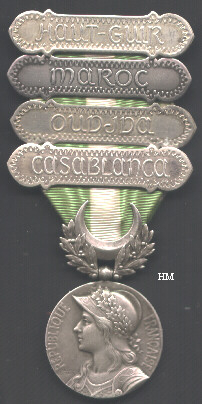
A special series of clasps was
created in commemoration of missions which had been the subject of great popular interest
and symbolism at the time, the "Grand Missions". They are recognisable by their
entirely different form although privately manufactured rectangular bars of the
"usual" type do exist.

|
(30 June 1903) : three expeditions, all lead by René Savorgnan de
Brazza, were mounted over a period of 10 years, between 1875 and 1885. These exploration
missions finally resulted in France obtaining an Equatorial Africa colony. The number of
people taking part in these missions was always very small and thus this clasp is rarely
found, especially as by the time it was finally awarded, in 1906, many of the expeditions'
members were no longer around to claim it.
A gold clasp was awarded although a
silver gilt one, made by Arthus-Bertrand is thought to be contempory as well. At least two
privately made, rectangular, bars are known to exist as well.
|
 
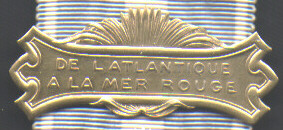
|
(4 July 1899) : the reasons that lead to this "Congo-Nile"
mission are complex but suffice to say that the French thought it necessary to have a base
at Fachoda, on the Nile river, and mounted an expedition to that effect starting on the
other side of Africa, in their Congo colony. Leaving the latter in March 1897, the French
expedition arrived at Fachoda on 15 July 1898 after a phenomenal journey across the
continent. Having attained their goal, the expedition members suffered a Mahdi revolt
attack and ended up being besieged by a British commanded force. In the end, French
politicians gave in and the town was vacated and handed over to the British.
Various types and executions of this
clasp are known, the original ones (drawing on the left) were in gold and are believed to
number only 13 and were awarded to a selected few members of the expedition. A second
model, identical to the original but in metal, seems also to exist but is of poor quality.
The third model, in gilt or silvered (see left) and was manufactured first by Mercier,
later by the Paris Mint. It would appear that from the many different types of this third
model, one silver type (with specific maker's and silver markings) was awarded in the
early 1900's to those other members of the expedition that were not amongst the original
recipients. The other types of this third model must be considered to be restrikes. Two
rectangular, privately made, bars are known to be in existence.
|

|
(22 February 1901) : on 27 September 1898 an expedition force of 321 men
left Biskra in Algeria to march to Lake Tchad and link up with two other expeditions which
were leaving from the Soudan and the Congo. The route taken, straight through the Sahara
desert, was frought with difficulties, thirst and the permanent hostility of the Touaregs
being the principal ones. Nevertheless the expedition reached its goal on 2 February 1900
and all three expeditions were finally united on 21 April 1900 thus making a symbolic link
of the French territories of Algeria, Soudan and Congo.
Three models for this clasp are known,
the original one having a gold and a silver-gilt version, as well as at least three
privately made, rectangular, bars. The gold first model, made by the Paris Mint before
1906, is believed to be the actual one awarded to the mission's participants.
|
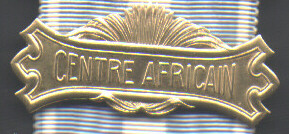 
|
(28 May 1902)
: as mentioned with the previous clasp, two other expeditions headed for the
rendezvous-point at Lake Tchad. One left from the Congo in 1897 and setting up various
garrisons on the way as well as being held up by fighting skirmishes with native forces
met up with the second which had left the Soudan on 13 January 1899. After fighting it out
with one more local chief, this joint force made it to Lake Tchad on 21 April 1900.
Two models of this clasp are known, the first one
having various types, as well as at least three privately made, rectangular, bars. Clasps
of the first model, in gold for Europeans, in silver for native soldiers, were awarded to
the members of both expedition forces. |
OTHER REGIONS :
THE INTERBELLUM CAMPAIGNS
WORLD WAR II CAMPAIGNS
instituted by the Vichy
Government :
instituted by the Free French
Government :


|
(27 May 1943) : for
minimum 2 years war service in French Equatorial Africa from 26 August 1940 onwards. |
 |
(6 November 1942) :
awarded to the members of the Free French Forces that participated, alongside British
forces, in the recapture of Somalia in 1941. |
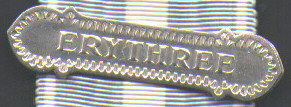 |
(26 March 1942)
: this clasp was awarded to the Free French military that took part in operations, once
again alongside the British, against the Italian occupying forces in Erythrea (February to
April 1941). |


|
(1 August
1942) : awarded to the Free French military that took part in military operations, once
more alongside the British, that lead to the defeat and surrender of the Italian forces in
Ethiopia (1941-1942). |
 |
(26 March 1942) : this
clasp was awarded to all that took part in actions against the Italians and Germans in
Lybia (1940 to 1942). |


|
(26 March 1942) :
awarded to the members of the Free French operation against the Italian forces that
occupied the Koufra oasis area in the Lybian desert. Under the command of French Colonel
Leclerc a force of 400 men left Tchad, traversed 500 kilometres of rocks and sand, to
attack 1,200 Italians that occupied the Koufra basin with its 6 oasis. Between 9 and 28
February 1941, the small French force besieged the area's strongpoint, the fortress of El
Tag, until its surrender. |
 |
(1 October
1942) : Also situated in the Libyan desert, the old fortress of Bir Hacheim stood in the
way of Field-Marshal Erwin Rommel's Afrika Corps attack on Egypt. 3,500 Free French under
French General Koenig defended the position between 27 May and 11 June 1942 and withstood
continuous attacks by the Italian Ariete Division, bombardments by German dive-bombers and
heavy artillery fire. Holding out for more than the 7 days requested by the British, the
surviving troops withdrew at night through a 60 metres gap in the enemy lines, suffering
heavy casualties, to regain the British lines 15 kms to the south. |
 |
(7 January 1944) :
awarded for the same action as the previous clasp, this bar seems to have been renamed for
phonetical reasons. |


|
(26 March 1942) :
awarded to the small force under General Leclerc that succesfully attacked the Fezzan
region, a vast desert area in Lybia about the size of France itself. The some 500 men,
after leaving their base some 600 kms to the south, defeated most of the Italian forces
occupying the Fezzan territory in February and March 1942. |
 |
(23
February 1943) : this clasp commemorates the war operations in the Libyan provinces of
Fezzan and Tripolitania between 19 December 1942 and 23 February 1943. |
 |
(7 January
1944) : this bar is a variation of the previous one but is nevertheless official as the
decree instituting it did no longer make a distinction between the two Lybian provinces. |
 |
(7 January 1944) :
awarded to the members of the Free French Forces that fought in the area in those years,
up till the end of the operations in North Africa on 13 May 1943. |
POST-WORLD
WAR II CAMPAIGNS
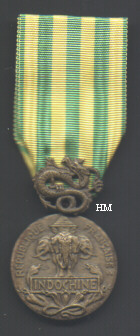

|
(4 June 1947) : a serious revolt broke
out on 29 March 1947 and it would take till well into November before various operations
managed to bring about a calm state of affairs again. Those that had participated in these
operations received this clasp which had originally been in use in 1895. |
SOME
OF THE UNOFFICIAL CLASPS
A big "Merci" to J.-P. Cote for
the use of his excellent drawings !
|


![]() to "The
French Colonial Medal"
to "The
French Colonial Medal"